By Vic Fogle
In wintertime Oregon you do what the weather lets you do. You try to fit your chosen activity into: A. cold and fog, B. somewhat warmer temperature and rain, C. wind and rain, D. clear and cold, or E. snow. And you don’t even get your choice. For example, the day before Albany’s winter machine gun shoot, this writer drove through rain showers to get to the range to fill plastic water jug targets in a near-freezing fog. Either rain showers or snow was the prediction for the day of the shoot, and, indeed, part of Saturday’s trip was made through rain showers. But some days turn out so you think you’ve gotten away with something-days that are even better than you dared to hope for. We were privileged to enjoy such a day for the shoot.
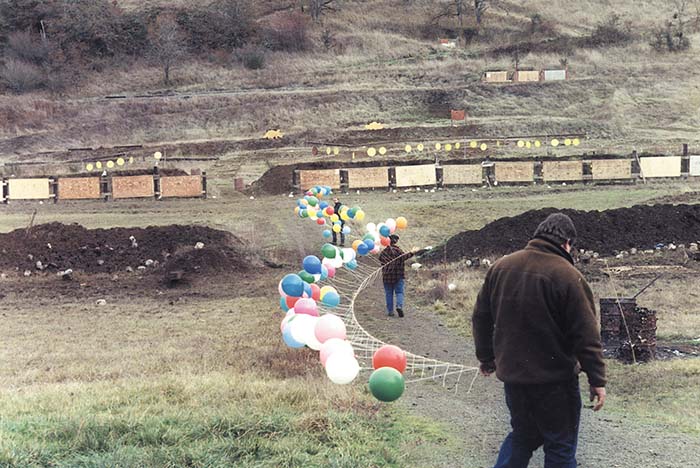
Well before daylight there were vehicles lined up at the gate. The writer has never understood the reasoning behind holding the shoot two weeks before Christmas, but perhaps this timing gives participants a break from the enforced cheerfulness and chores of the holiday season. At any rate, several hundred hardy souls temporarily escaped Christmas shopping to make noise, have fun, and think about something else. No rain yet, just heavy clouds.
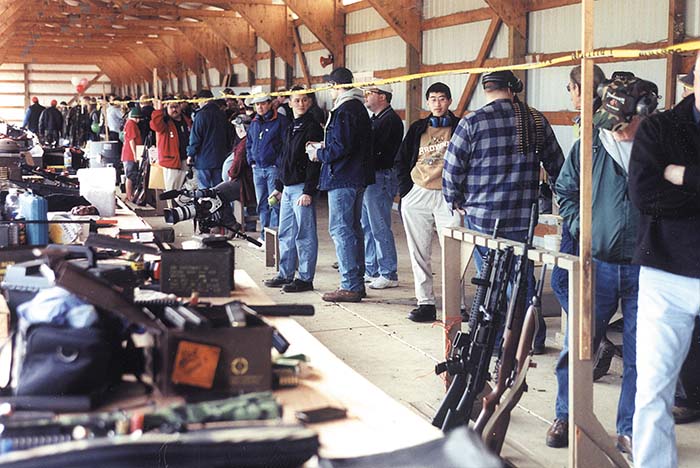
Everything seemed to come together part way through the shoot as event director Mark Cook briefly interrupted shooting long enough to inform everyone that the U.S. Supreme Court had overridden its Florida counterpart and had stopped the most recent recount in the Endless Election, our period of electile dysfunction in which the highest court in the land, in George Will’s words, “signaled checkmate against Al Gore’s protracted search for a way to get a court to make him president.” The result was a loud cheer that put everyone in an even better mood. About that time the heavy clouds broke up, and the range was covered with bright sunlight that remained throughout the afternoon and produced a high of 50 degrees. A good omen for shooters? Let’s hope so. We’re overdue.
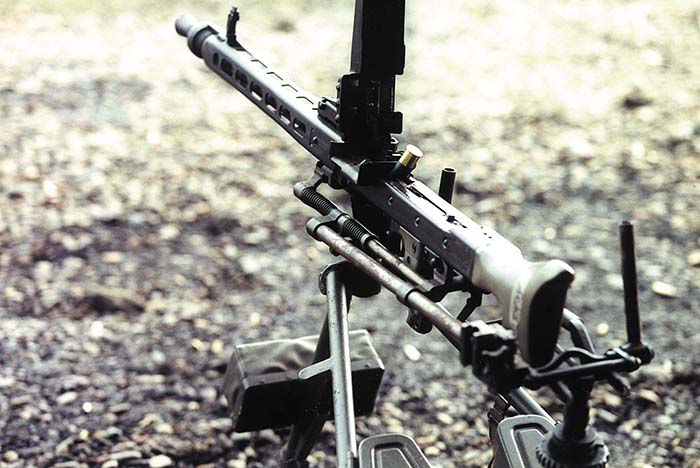
As shooters came to the firing line in the early morning gloom, they soon laid out an impressive display of weaponry and accessories of all kinds. The most popular piece was, understandably, the M16 in a number of variations and calibers, of which short barreled versions predominated. These, in turn, sported a wide range of muzzle attachments. Joining the M16’s in the assault rifle category were a mix of AK47 variants and what appeared to be either a German Kar 44 or MP44/StG44; both were among the first assault rifle prototypes. Among belt feds, light machine guns of Browning design, mainly 1919 A4’s, dominated the field, along with several BARs. In addition, there were a couple of M60’s, a couple of MG34’s, at least three MG42’s, and a delightful veteran Maxim MG ’08. Then there were many submachine guns of several calibers, including Thompson’s, Uzi’s, Mac’s, grease guns, Sten’s, Yugo 49’s, PPSh 41’s, and a few unique items such as an FN P90. The latter is a futuristic looking creation in 5.7mm caliber that was originally intended for support troops but that is also being used by law enforcement agencies. SAR has covered the P90 in military issue in past volumes.
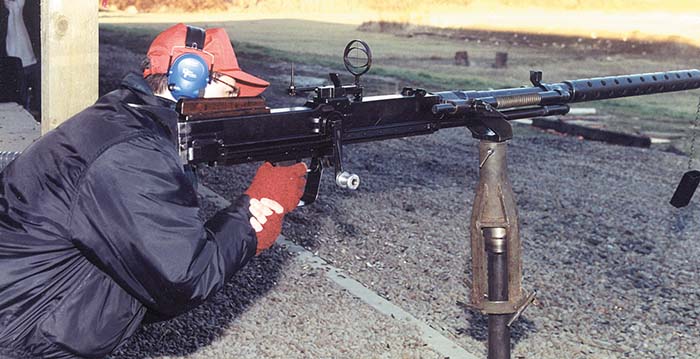
There seemed to be a better than usual representation of .50 caliber arms both in Ma Deuce machine guns and in .50 caliber rifles. These were interspersed wherever the owners wanted to setup, but because even this spacious firing line was crowded, it seems likely that in the future the .50’s will be together in one section.
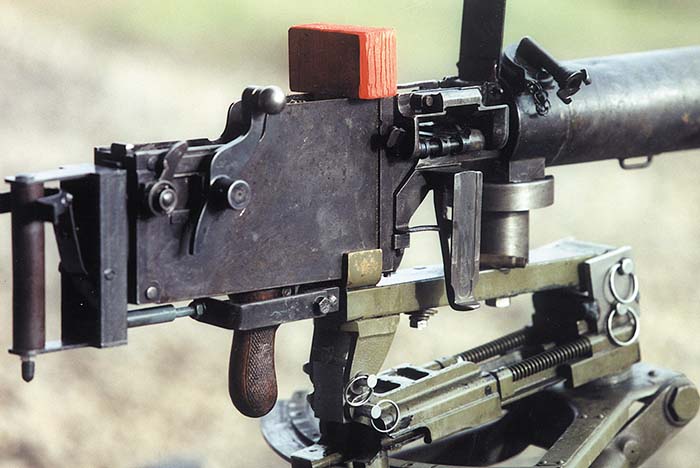
One inventive .50 caliber rifle shooter fashioned a rest almost four feet high of black plastic pipe, the top of it was made half-round, with caps, and the rifle’s bipod feet rested in this so that the shooter could sit more or less upright on a stool and be out of the gravel. Moreover, when shooting a .50 caliber with this rest, recoil was much less punishing than it would have been in the prone position.
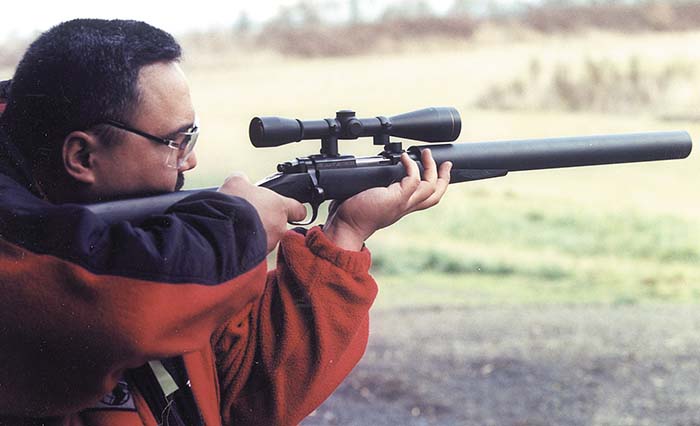
Shooters enjoyed a wide choice of targets. In addition to water filled plastic jugs, there were suspended painted lids from 55 gallon steel drums. Non-reactive targets at 200 yards were a tank and a Jurassic creature, both cut from plywood and painted, and overhanging everything were long strings of gaily colored helium filled balloons that were replenished at every break in shooting.
During the afternoon, an enthusiast from another state brought the largest guns, a pair of real showpieces. The first was a beautiful Solothurn 20mm on an original wheeled carriage. Since the company that made this model was physically located in Switzerland, Americans have long wondered why the Swiss, who did not participate in World War II, made so many of these guns that they were widely offered for sale cheaply during the 1950’s. The answer is that following 1929 the plant was partially controlled by Rheinmetall-Borsig, the biggest munitions company in World War II Germany, and this company used the Swiss location to circumvent Allied restrictions on German automatic arms development and production during the inter war period.
Right beside the Solothurn, standing upright when it was at rest, was Don’s Lahti 20mm on a modified stand. The part of the stand attached to the gun was an original cylindrical cage “tree” mount with large take-up screws at the right angles to its axis. When the Finns used this, they cut off a small tree several feet off the ground, set the cage part down over the stump, and then tightened the take-up screws to hold the gun in place, much as some Christmas tree stands work. The present owner fitted a vertical adapter that entered the cage to a wide-foot .50 caliber tripod, so now the gun is held about 4 1/2 feet off the ground and can be fired standing up in treeless areas. Recoil was surprisingly mild, although if fired repeatedly without earplugs it would sell a lot of aspirin.
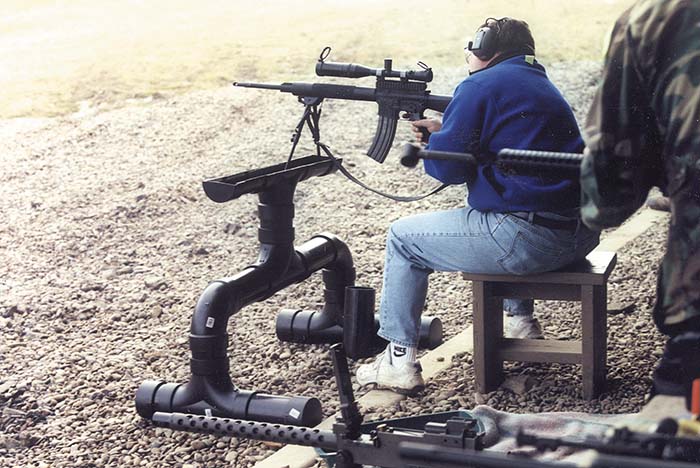
A break of sorts, at least in noise, was created about noon when there was a half hour period limited to suppressed guns. A surprising number of them immediately appeared, representing specimens from numerous manufacturers. Tom Denall, of Bend, Oregon was there to show the Ruger bolt action .44 Magnum rifle that he suppresses, and Gemtech, of Boise, Idaho had a table with suppressors and catalogs. There was a suppressed .50 M2 on the line, but its suppressor, about a foot long and 2 1/2” in diameter, was so short that the spectators could see powder burning well in front of the opening, and like the suppressed .50 at Knob Creek a couple of years ago, it proved that trying to suppress a .50 with a small can while using full velocity ammo can be a waste of time.
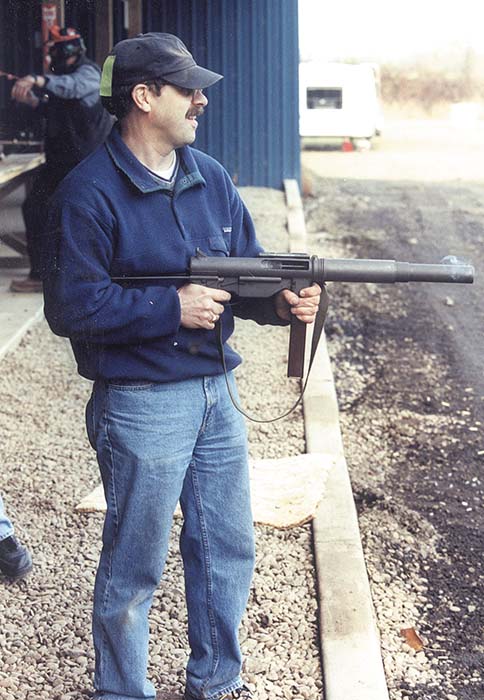
Once again, a very high percentage of attendees came to shoot. By no means all brought guns, but they know that vendors always being a wide variety to rent. Albany admits all those who have paid the “shooter” rate to the firing line, rather than restricting the number of “shooter” badges. This arrangement is especially appreciated by those living in non-Class 3 states such as Washington and California. Most of those who enter as spectators succumb to the appeal of shooting and they are able to become shooters by merely paying a small additional charge for the “shooter” identifying ribbon.
Albany hosts submachine gun matches on the second Sunday of most months, but the next open shoot of this magnitude will be the weekend of May 19-20, 2001. Then, in addition to this kind of informal open shooting, state championships for submachine gun, assault rifle, crew served, and belt fed competitions will be decided. These championships are fired mainly at steel plates of various sizes which require combat strength loads to knock them down, and are quite popular.
Updates and further information are available from: Albany Rifle and Pistol Club, Box 727, Albany, Oregon 97321. The website is www.proaxis.com/arpc For those bringing guns, the 5320.20 address is: Albany Rifle and Pistol Club, 2999 Saddle Butte Road, Shedd, Oregon 97377. Mark Cook, the Event Director may be reached at 541-745-5619.
| This article first appeared in Small Arms Review V4N9 (June 2001) |











